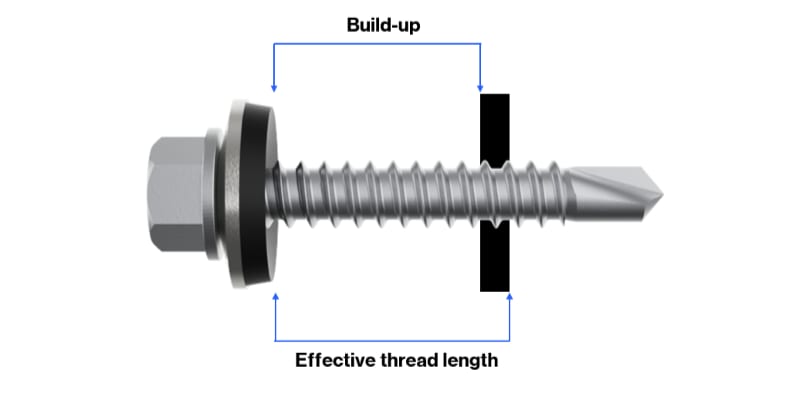
Build-up versus effective thread length - what's the difference?
- Read time: 1.5 minutes
- Date: 21 Feb 2024
- Sheeting & Cladding
Here's what we'll cover below:
What is build-up?
What is ETL?
What's the difference between them?
How do I work out ETL?
Which fastener do I need to use in which application?
What is build-up?
Build-up is the total thickness of everything a fastener is being used to fix - it's measured from the top of what the fastener is fixing to (e.g. a purlin, rail, or deck), to the underside of the head - or if there is a washer, to the underside of the washer. It's sometimes referred to as 'fixture thickness'.
What is ETL?
ETL stands for effective thread length, and measures the total length of fastener that can be used in application. It is sometimes referred to as 'clamping thickness'.
What's the difference between build-up and ETL?
Build-up looks at the thickness of the material the fastener will be able to cope with.
ETL looks at the product and how much of the thread on the fastener can be used - the thickness of everything the fastener will pass through: the material being fixed back, and the substrate.

How do I work out what the ETL is for a fastener?
You don't need to work out what the ETL is of a fastener - they're published online and in our latest product directory.
How do I know which fastener to use in what application?
You need to find out how much material the fastener is going to pass through, including the substrate - and what that material is. We've put together a checklist for you to use when selecting the correct fastener to use for an application.
What and how thick is the substrate you are fixing into?
What are you fixing to the substrate? (e.g. a composite panel, or a sheet)
How thick is this material?
What fastener material is required?
A4/316 Stainless steel
A2/304 Stainless steel
Carbon steel
'A5' HCR steel
Is a washer required?
Yes
12mm
15/16mm (Wall/vertical applications)
19mm (Mainfix roof applications)
29mm (Rooflights)
No
What head style is required?
Coloured
Moulded bi-hex (MatchFast)
Low profile lacquered (DrillFast low profile lacquered)
Hex and cap (DrillFast and hex caps)
Plain
Mill finish hex (DrillFast)
Low profile mill finish (DrillFast low profile)
Is there anything else about the application Fixfast need to know?
E.g. it's a crown fix or valley application.
Our Tech team are on hand to talk through unique applications with you - get in touch
As an example:
What and how thick is the substrate you are fixing into?
Light gauge 1.8mm
What are you fixing to the substrate? (e.g. a composite panel, or a sheet)
Single sheet
How thick is this material?
1.2mm
What fastener material is required?
A4/316 stainless steel
Is a washer required?
Yes - 19mm
What head style is required?
Mill finish hex (DrillFast)
Is there anything else about the application Fixfast need to know?
No
So the fastener is fixing a 1.2mm sheet to 1.8mm light gauge steel: 1.2 + 1.8 = 3mm.
The fastener needs to be A4/316 stainless steel, with a 19mm washer and a hex head.
Using the published ETL data from our product directory, a DF3-SSA4-S19-5.5 x 35 will be the correct fastener to use, as this has a min ETL of 0mm, and a max ETL of 14mm. The fastener required only needs to cope with 3mm, so this is more than enough.
Please note that is is how Fixfast calculate the fastener to use in a situation - and this calculation can vary depending on the manufacturer. Always check with your fastener supplier of choice if you are unsure.








